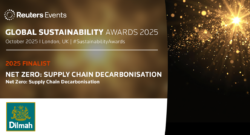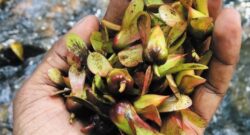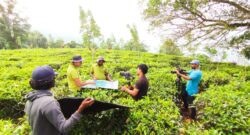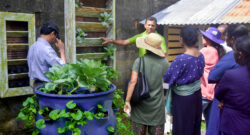Author: Diyani Perera
Prestigious Reuters Global Sustainability Awards recognises Dilmah as Finalist
Dilmah Tea is proud to announce that we have been recognised as a finalist for the Net Zero: Supply Chain Decarbonisation award category at the prestigious Reuters Global Sustainability Awards. This recognition highlights Dilmah’s commitment to reducing emissions across its supply chain, aligning with its long-standing ethos of sustainability, ethical business practices, and environmental stewardship. As a global tea brand, we are embedding sustainability across its value chain through a science-based, supply chain-led climate strategy. With validated targets from the Science Based Targets initiative (SBTi), the company has committed to reducing Scope 1 and 2 emissions by 46.2%, Scope 3 emissions by 27.5% by FY2031, and achieving net-zero by 2050. Dilmah is the first company in Sri Lanka’s food and beverage processing sector to have its near-term, long-term, and FLAG targets validated by SBTi. Scope 3 decarbonisation is key to Dilmah’s net-zero pathway. The company is cutting emissions across cradle-to-grave operations through sustainable product innovation, low-emission logistics, improved energy efficiency, local sourcing and nature-based solutions. Recent initiatives reinforcing this strategy include: Dilmah’s strategy is guided by the TCFD framework, with climate and biodiversity risks integrated into enterprise risk management. A double-materiality approach ensures that both business and environmental impacts are addressed. Innovation and collaboration strengthen these efforts: Active in over 100 global markets, Dilmah drives accountable sustainability aligned with the UN SDGs delivering lasting impact across its operations and the tea industry.
From Extinct in the Wild to Critically Endangered
Pini Beraliya (Doona ovalifolia) takes root again through the overarching work of Dilmah’s Endane biodiversity Corridor Pini Beraliya (Doona ovalifolia) was listed as extinct in the wild in Sri Lanka’s 2012 National Red List. Its story took a hopeful turn when it was rediscovered in three locations—Ayagama (Sabaragamuwa Province) , Kelin Kanda (Western Province), and Wewella (North Western Province) —through wider research linked to Dilmah’s Endane Biodiversity Corridor. Since then, 250 saplings have been cultivated under special conditions at the Endane Plant Nursery. Pini Beraliya favours water banks, and it’s no coincidence that all three known populations were discovered in different locations – each near a water body. On August 7th, together with the Wewella community from Walallawitta we planted 12 of these in Wewella, marking a meaningful step towards restoring this rare species in its native habitat. The rediscovery of a plant previously listed as “Extinct in the Wild” holds powerful significance for conservation. It offers a rare second chance for a species once thought lost in nature, renewing hope and momentum in global biodiversity efforts. Such discoveries highlight the importance of continued fieldwork, local ecological knowledge, and habitat protection. They also higlight the urgency of safeguarding these newly found wild populations, which are often small and vulnerable. Beyond their symbolic value, rediscovered plants may carry unique genetic traits crucial for long-term species resilience. These moments can inspire public interest, attract funding, and drive stronger conservation policies—serving as reminders that nature, when given the chance, can still surprise and recover. Scientists, conservationists, academics, forest department officials and Wewella community gathered to celebrate this special event. The Scientists and conservationists who discovered the plants told the community of the importance of Beraliya plant and handed over the responsibility of caring for the planted saplings. The Sign reads: This location, where Pini Beraliya, a critically endangered plant species endemic to Sri Lanka, is found, is one of the very last remaining places where it exists Known by the scientific name Doona ovalifolia, it belongs to the Dipterocapacea family( Common name: Hora). Highly valuable and containing medicinal benefits this plant is protected under the the Flora and Fauna Protection Act No. 22 of 2009.
Sri Lanka’s Biodiversity Just Got a Big Boost
Dilmah Tea supports significant milestone in Sri Lanka’s botanical history in the last 100 years This July marked an exciting milestone – the book Discovery: Additions to the Flora of Ceylon by Dr. Himesh Jayasinghe was officially launched and is already being hailed by experts as one of the most significant contributions to Sri Lanka’s biodiversity in the last 100 years. Published by Dilmah, it features 210 plant species, including 150 completely new to science, along with over 4,000 detailed photographs (mostly taken by Dr Himesh Jayasinghe himself) and 200 illustrations making it both visually captivating and scientifically accurate. With 95% of Sri Lanka’s wet-zone forests disappearing this book is an urgent reminder and call to protect what is fast disappearing. The Beginning of a Partnership Rewind to four years ago, a promising meeting brought together three people with a shared passion for Sri Lanka’s biodiversity. At the heart of it was Dr. Himesh Jayasinghe, a botanical savant known for rediscovering species thought to be extinct – and uncovering entirely new ones. He was introduced to Dilhan C. Fernando, Chairman of Dilmah Tea, by Rohan Pethiyagoda, one of Sri Lanka’s most respected biodiversity scientists and Linnaean Medal winner who also edited the book. Dilhan was struck by Jayasinghe’s deep knowledge, enthusiasm, and the potential impact of his work on conservation in Sri Lanka. The discovery of 150 species of flowering plants new-to-science by one researcher is no small feat. That meeting didn’t just end in tea – it led to funding Himesh’s research and the birth of this remarkable book to showcase his remarkable discoveries. At Dilmah, this partnership is part of a broader mission: an enduring commitment to biodiversity. That’s why Dilmah drives initiatives like the Endane Biodiversity Corridor and the Climate Change Research Centre, focusing on science-based reforestation and climate research. We have produced several nature-based publications including field-guides to make knowledge accessible to all. Discovery Additions to the Flora of Ceylon is our latest offering. ‘As Sri Lanka looks into its post-crisis future, we need to understand this singular importance of biodiversity for the survival of our businesses. Himesh has documented the richness of our nation and he should be facilitated as a hero. So let’s think differently about what we have and I hope that this incredible publication will enrich our knowledge further’ – Dilhan C. Fernando, Chairman, Dilmah Tea The Journey of Discovery Once a civil engineer, Dr. Himesh Jayasinghe followed his heart into the wild world of plants – and thank goodness he did. His work has led to the rediscovery of over 100 species once feared lost and introduced 150 brand-new species to science. Add to that 39 already-described species that are new to the flora of Sri Lanka and 8 discoveries that relate to taxa previously reported from Sri Lanka but are not formally recorded, and you have got a true botanical bonanza. Of course, this didn’t happen overnight. It has been a decade of field work and research for Jayasinghe and his team, scouring forest, savannahs, wet zone, dry zone and the mountains around Sri Lanka for new plants. No easy task and not for the faint hearted, Jayasinghe often had to make several trips just to record one species as most trees flower and fruit at different times of the year (it is rarely possible to document both flowers and fruit simultaneously!). Sometimes there were several variations of the same species – these had not been mentioned in reference books. Documenting them meant patience and persistence. But for Himesh, it’s all worth it. Above: The author in action – Dr. Himesh Jayasinghe has explored all over Sri Lanka identifying and photographing over 3000 flora. A Future for Flora And here’s the real heart of the matter: this book isn’t the final word – it’s just the beginning. When Jayasinghe began his research, the best reference available for anyone was the Revised Handbook to the Flora of Ceylon – A 14 volume reference compiled from 1964-2000 and authored by 64 botanists from 27 institutes. Helpful? Yes. Perfect? Not quite. No photos. Few illustrations and many puzzling inconsistencies that made identifying plants and trees a real challenge. Dr Rohan Pethiyagoda said: “But with Himesh’s photographs of Sri Lanka’s 3000 odd plant species we are now at a place where we can have an illustrated companion of the (Revised Handbook to the) Flora of Ceylon.” But here is the kicker – he also said it would take at least eight more volumes to do it justice and stressed why it is therefore important to buy and support this book and in that the future work. Further, Jayasinghe has already collected a wealth of plant samples, but there’s still much to be done – measuring, recording, and documenting them all – and he’s calling on student researchers to roll up their sleeves and join him. Conservation with A Purpose At the book launch, the Author shared bits and pieces of his unique journey to find and identify rare and extinct plant species – turning even the few casual attendees present into believers. He also highlighted a key point: conservation must be guided by ecological understanding. Reforestation is not just about planting trees – it is about protecting the forests we already have and, where needed, restoring the right conditions for species to survive. Simply planting trees and hoping they will become a forest will not work. With climate change adding pressure and countless other threats looming for the survival of plants and trees, the only way forward is through science, action, and teamwork. Governments, companies, communities, young scientists—there’s room (and need) for everyone in this mission.
Documenting the Story of our Biodiversity Corridor
For over five years, we have been working to connect two fragmented areas of protected forest by creating a biodiversity corridor through a degraded tea plantation. Our efforts caught the attention of the renowned Franklinia Foundation, and we were fortunate to receive a grant to further our work, particularly in the conservation of rare and threatened tree species through this project. Now, we are ready to share our story with the world. Over the past few months, we have been working on a documentary that will tell the story of the Endane Biodiversity Corridor. It highlights not only the positive impact on biodiversity but also the benefits it brings to the local village and estate community surrounding the forests. Further, it explores how this project could serve as a model for forest restoration initiatives in other parts of Sri Lanka and around the world. Here are some behind-the-scenes glimpses…
Making Nature Learning Fun – “Schoolyard Stories” – Exhibition and Storytelling Festival
Dilmah Genesis Centre Hosts Young Scientists and Educators on a 2-day Celebration of the Natural World Genesis: The Dilmah Centre for A Sustainable Future was buzzing with energy on the 15th and 16th of February as young minds and nature lovers gathered for a day of exploration! The Schoolyard Scientists turned the space into a celebration of natural science, creativity, and learning. There was something for everyone. Exhibits that showcased discovery and action… Expert talks and panels about conservation, education and storytelling… Immersive sessions: storytelling and art to connect with nature… Virtual Reality (VR) experiences that let participants immerse themselves in Sri Lanka’s ecosystems… Schoolyard Scientists is a local organisation dedicated to helping young learners connect with nature and guiding educators to rethink teaching methods that inspire curiosity. Their initiatives include leading Bioblitz events, transforming schoolyards, and fostering community engagement. Genesis is a community hub for those passionate about sustainable practices and innovation across fields like agriculture and education. We facilitate a collaborative space for innovation, hosting initiatives and events. Past events like Lost Ingredients Lab and the Scale Up Shop have supported sustainable entrepreneurs by connecting them with experts for mentorship, helping them advance their innovations and prototypes.
Event: Dusk to Dawn: Exploring the Wetland Wonder
Experiencing and Understanding the Urban Wetlands from Dusk to Dawn In Honour of World Wetlands Day 2025 Wetlands are delicate ecosystems, but their importance goes far beyond the surface. Dilmah’s “Dusk to Dawn” event held in honour of World Wetlands Day served as an eye-opener to wetland biodiversity, the challenges of these ecosystems and reasons why we should protect wetlands. Held on two consecutive days (1st and 2nd Feb), the event invited the public (free of charge) to explore the Beddagana Wetlands, part of the Colombo Wetland Complex – the world’s first Ramsar-accredited capital wetland city. The event wasn’t just about seeing the wetlands; it was about understanding them. Knowledge-sharing sessions in the backdrop of Beddagana wetlands were led by experts setting the foundation for the highly anticipated portion of the evening – the wetland night walk. Day 1 Narmada Dangampola, Environmental Educator at Dilmah Conservation, and Rukmal Ratnayake, Conservation Biologist, captivated the audience with a session on nocturnal animal behaviour and calls, allowing participants to hear the actual sounds of these hidden creatures. This was followed by sessions on mist netting and Sri Lankan bats by Dr. Tharaka Kusuminda, and an introduction to camera trapping techniques by Anya Ratnayaka. Then it was time to go on the night wetland walk… Groups of participants, guided along the trails, discovered the quiet life that thrives in the darkness – although the music blaring from nearby residential spaces and dog barks occasionally disturbed the stillness! Butterflies, dragonflies, spiders, centipedes, paddy field frogs, fish and lesser whistling ducks were seen resting. Bird calls echoed through the night air, as participants challenged themselves to identify each call they heard, immersing themselves in the rhythms of the wetlands after sundown. The event also sparked important conversations about the future of Sri Lanka’s wetlands. A panel discussion moderated by Narmada Dangampola brought together key figures in conservation, including Prof. Devaka Weerakoon, Nishanthi Perera, and Chandana Kalupahana. They shared insights into the wetlands’ Ramsar status and discussed the crucial steps needed to ensure the health of these ecosystems for years to come. Dr. Weerakoon emphasised the true value of these ecosystems, stating that Colombo’s wetlands provide services worth an estimated LKR 16 billion annually. He also highlighted the role of urban wetlands in flood defense, particularly in cities like Colombo, where the risk of flooding is high. Day 2 On day two, an early morning guided walk took participants into the wetlands once again, but this time with a twist. Children joined a scavenger hunt, eagerly seeking out native and endemic species, while gaining hands-on knowledge about the plants and animals that populate these vital ecosystems. The event left participants with a renewed sense of responsibility, especially the younger generation, who will be the ones who continue this important work. The Beddagana Wetland Park is a collaboration between the Urban Development Authority of Sri Lanka and Dilmah Conservation to enhance opportunities for wetland education at the park. Since the collaboration began a year ago, more than 500 individuals have participated in educational programmes at the park, a clear indication of the success and positive impact of this pioneering public-private partnership.
Once a Dumping Site, now a Thriving Hub of Organic Urban Home Gardening
In the heart of Moratuwa, a once-polluted space, damaged by industrial waste has undergone a remarkable transformation. The land, once filled with degrading nylon and toxic chemicals, seemed unfit for life until Dilmah Conservation took on the challenge. Restoring a degraded environment is no simple task. It’s not just about soil; it’s about reviving an entire lost ecosystem, an effort that takes time, patience, and commitment. Over a decade, our team worked to restore soil health and reestablish ecological balance. Today, this land stands as a thriving research hub, advancing studies in organic gardening, ecosystem services, and soil sciences. A Model for Sustainable Farming Spanning approximately 100 perches (0.62 acres), the Organic Farm at the One Earth Centre, Moratuwa cultivates a wide variety of herbs, fruits, and vegetables ranging from upcountry crops like kale to low-country staples such as brinjals, long beans, and chillies. The harvest supports multiple initiatives, including the MJF Charitable Foundation’s weekly sales and twice-weekly vegetable collections by WDP all driven by the vision of our founder, Merrill J. Fernando: “Business is a Matter of Human Service.” But this space is more than just a farm; it’s a learning hub, a model for creating economically viable organic gardens in limited urban spaces. From traditional farming methods to innovative techniques, visitors can explore: Vertical Gardens – balcony gardens, crop towers, keylock gardens, tripods, and crop tables. Aquaponic Systems – supporting gardening in a soilless environment. Sustainable Farming Techniques – mixed cropping, crop rotation, permaculture, mandala gardens, and protected houses. Fertiliser Production – liquid fertilizers such as vermiwash, vermicompost, and jeewamrutha from organic waste. Biogas Units – generating affordable renewable energy for home use. A Centre for Learning & Research Being equipped with an arboretum, butterfly garden, and model organic farm, our Moratuwa One Earth Centre is the go-to spot for learning and research. This is where we hold educational lectures, facilitate hands-on practical sessions, and research projects, giving students real-world exposure. University students, like those from Sri Jayawardenapura University’s Department of Urban Bio-resources, come here to explore soil fertility, sustainable farming, and farm design, gaining knowledge as part of their practical component learning to apply them beyond the classroom. It’s also the perfect place for Parisara Niyamu (Environment Pioneers) to complete their requirements and earn their medals, with plenty of guidance on organic home gardening. In 2024, we had the pleasure of hosting students from 22 schools in the Colombo District, equipping them with the tools to bring sustainable practices back to their communities. With a total of 2500 visitors benefiting from our programs this year, each session wraps up with a guided tour, sparking a deeper passion for protecting our planet. Parisara Niyamu (Environmental Pioneers) undergoing practicals so they can be awarded Merit Badges. We believe these young minds will carry this knowledge forward, applying it in their own communities and shaping a more sustainable future.







